Adam Yamey's Blog: YAMEY, page 149
September 18, 2021
Travelling abroad at last
WE ARRIVED IN ENGLAND from India on the 27th of February 2020. Because of the covid outbreak, we had not left England until today, the 13th of September 2021. Some, especially those who live there, regard Cornwall as being another country, rather than part of England. We have visited that southwest county of what most people regard as England, since we arrived back from England. So, it would be pushing things if we said that we went abroad to Cornwall,
Today, we travelled abroad, leaving England for a few hours. To reach our destination we did not have to take covid tests or show evidence of double doses of vaccine or, even, show our passports. However, leave England we did. We crossed the River Severn to leave England and enter Wales. Crossing the Severn Bridge on the M48 did not require us to pay a toll as used to be the case, as the crossing is now free of charge. A few years ago, a toll was charged for crossing into Wales, but no longer; it has been abolished.
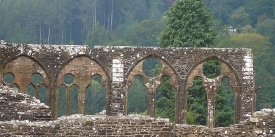 Tintern Abbey
Tintern AbbeyWell, I hear you say, Wales is not exactly ‘abroad’, but when one has not left England for over 18 months, it will do as ‘abroad’. Wales has its own parliament and most signs, be they on the road or elsewhere, are bilingual (English and Welsh) and, if you are lucky, you will meet a speaker of the Welsh language. To us, crossing over into Wales, after so many moths without foreign travel, felt like going abroad.
We drove along the beautiful Wye Valley and stopped at the attractive ruins of the former Cistercian Tintern Abbey (Abaty Tyndyrn in Welsh), the first ever Cistercian foundation in Wales. At the ticket office, I expressed my joy at being abroad after so many months, and the cashier said to me in a gently Welsh accent:
“I like your style.”
We have visited Tintern Abbey (founded 1131) many times in the past and each time it has been a wonderful experience. Today was no exception. Set in a wooded valley, the ruins of the gothic buildings look great against the background of trees with dark green foliage. After spending about an hour in Tintern, we drove along roads which were mainly in Wales but occasionally crossed the border into England. When we reached Wrexham (Wrecsam in Welsh), we headed off north and east into England, our trip abroad having been completed.
September 17, 2021
A new sculpture at Wells Cathedral
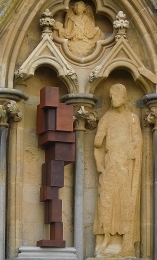 New metal sculpture by Antony Gormley at Wells Cathedral
New metal sculpture by Antony Gormley at Wells CathedralAmong the carvings
At venerable Wells Cathedral
Stands a novice
The sculptor Antony Gornley (born 1950) has added a new artwork (made of metal) to an empty niche on the west facade of Wells Cathedral in Somerset, England
September 16, 2021
A lonely chimney
A SOLITARY CHIMNEY stands in the middle of East Harptree Woods in the Mendip Hills of Somerset, not far from Bristol and Bath. This tall, not quite vertical, chimney and the surrounding uneven landscape is all that remains of the local tin and zinc mining activities in the area. Known as Smitham Chimney, this was built in the 19th century and was the exhaust for the toxic fumes created by the furnaces smelting lead-bearing materials. The unevenness of the surrounding area, now richly populated with a variety of trees, was caused by the pits and spoil heaps created during the era of mining activity. The chimney was built in 1867 and by 1870, the East Harptree Lead Works Co Ltd were producing about 1000 tons of lead per year (https://en.wikipedia.org/wiki/Smitham_Chimney,_East_Harptree).
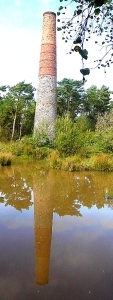 Smitham Chimney
Smitham ChimneyToday, the chimney stands amongst a fine collection of trees including conifers and birches, all growing in a sea of ferns and other bushes. Much of the woodland is mossy. Maintained by Forestry England, the Mendip Society, and Somerset County Council, the woodland has good, fairly level paths, easy on the feet. The place and its industrial archaeological feature make for a pleasant and interesting short excursion.
September 15, 2021
Swimming at the White House
MY PARENTS, ESPECIALLY my mother, were keen that I learned to swim. It took me a long time to learn this activity. For many years, I was taken to various indoor pools to take lessons with a variety of swimming teachers, some professional and others not. One of the latter was a young Asian lady, who gave me a few lessons in the pool at the White House. This was not the famous establishment in Washington DC but a 1930’s apartment block, now a hotel, near Great Portland Street Underground station in London.
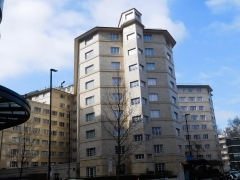 The White House, London
The White House, LondonThe teacher, who had no success with getting me to swim, lived in the White House and was recommended to my parents by another resident, a family friend, whom we knew as ‘Sakki’. Like my parents, Sakki was born in South Africa and my father told me that his family and Sakki’s were either remotely related and/or in business together. Both Sakki and my father were on the academic staff of the London School of Economics (‘LSE’). Sakki was the anthropologist Professor Isaac Schapera (1905-2003). He had become an expert on the anthropology of indigenous people of Botswana and South Africa. Amongst his many published works was “The Khoisan Peoples of South Africa”, published back in 1930.
Apart from providing me with one of my many swimming instructors, Sakki took a great interest in my sister and me. He gifted me several books, amongst which was several books about the adventures of Hergé’s cartoon character Tintin. These were in French and were volumes that were at the time neither available for sale in the UK nor translated into English. When I graduated with my PhD in 1976, he presented me with a two-volume book about magic, myths, and science.
In the very early 1960s, Sakki joined us on a family driving holiday in France in our smallish Fiat 1100. My mother, who had been involved in a serious car accident in the 1930s, had installed seatbelts in our car, a rare thing for the time. Sakki had to travel in the rear seat with my sister and me. Sakki had his own seatbelt (lap design), and my sister and I were strapped together in the other belt, separated from each other by a pillow. It soon became obvious to my parents that Sakki was not enjoying being confined in the rear of the car with two young children. My parents solved the problem by stopping at regular intervals at roadside cafés so that Sakki could enjoy a glass of cognac. This seemed to help him tolerate the journey, about which I remember little else.
During my childhood, Sakki was a regular visitor to our family home. He used to amuse us kids with comical verses, only one of which I can remember. It sounded to my ears something like this: “Olke, bolke, reeby, solte. Olke, bolke, knor.” While writing this piece, I looked for this on the Internet, and now know that what he was telling us was the words of an Afrikaans song that goes:
“Olke bolke Riebeeck stolke, olke bolke knor…”
Well, now, many years since I last saw Sakki, I know that what he was telling us was not his invention, as I had always believed as a youngster.
Sakki underwent surgery on his vocal cords. This affected his speech badly and drove him to avoid socialising in his later years. However, he did visit our home on at least one occasion after his voice had been affected. I was a young teenager then and I can still remember that when he spoke, all that one could hear was a hoarse, rasping, whisper. After conversing with me for a few minutes, he said to me:
“You don’t have to whisper just because I am talking so softly.”
And then he added:
“I have noticed that everyone with whom I talk gradually lowers their voice to a whisper whilst they converse with me. It is strange how the loudness of my voice affects that of people who are talking with me.”
That people unconsciously adjust their voices to match that of their interlocutors made a great impression on my young mind, and I have never forgotten it.
I do not believe that I ever met Sakki again between 1976 and 2003, when he died. By then, the White House had almost completely changed from being an apartment block to becoming a hotel. Sakki lived there until he died and was one of the place’s last full-time residents from the time before it became a hotel with a few flats.
And, just in case you are wondering, I did learn to swim eventually, not at the White House but in the pool of the old YWCA near to Tottenham Court Road station.
September 14, 2021
Eye-catching walls
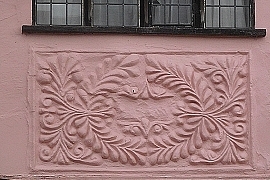 Lavenham, Suffolk: an example of pargetting (decorative plasterwork)
Lavenham, Suffolk: an example of pargetting (decorative plasterwork)Walls need not be dull
With decorative plasterwork
They can give joy
September 13, 2021
Three hares sharing only three ears
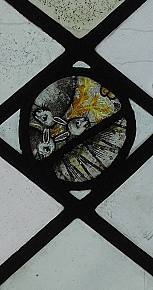
There is a lovely parish church in Long Melford, Suffolk. Called Holy Trinity Church, it is a fine example of the perpendicular gothic style, completed in about 1484. Some of its windows contain old pre-Reformation stained-glass. A tiny circular piece of stained-glass above the north door of the nave depicts something unusual. It is hard to see with the unaided eye, but if you can manage to see it properly, you will notice something interesting. Known as the Hare Window, it depicts the heads of three hares and three hare’s ears. Each hare appears to have the usual two ears, but each of the three ears on the glass are shared by a pair of hares.
Although unusual, the three hare motif is not unique to Long Melford. Another example, a ceiling boss with three hares sharing three ears can be found in the Chapter House of the Church of St Peter and St Paul in Wissembourg, France, and another on a bell at Kloster Haina near Kassel in Germany (http://www.chrischapmanphotography.co.uk/hares/page3.htm)
September 12, 2021
Don’t be fooled by Jack the rip-off
I USED TO PARK our car in Kensington’s elegant Edwards Square when going to work at my dental surgery in West Kensington. From the square, either I walked to work, or I caught a number 28 bus. When I felt lazy, I used the bus. The nearest stop to Edwards Square is outside a row of three Iranian food shops and their neighbour, the Apadana Iranian restaurant, which is a pleasant place to enjoy Persian cuisine. While waiting for the bus, I used to stare idly at the Persian shops with their outdoor stalls where fruits, especially piles of pomegranates, are displayed.
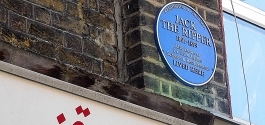
Today, more than four years since I retired and even longer since I last stood at the bus stop, we visited the Iranian stores to buy a bunch of fresh tarragon. While my wife was making the purchase, once again I stared idly at the colourful shops, some of whose windows are filled with stacks of tins of Iranian caviar from the Caspian Sea. It was then I noticed something I am sure I have never seen before.
What I saw was a newish circular blue commemorative plaque on the wall between one of the shops and Apadana. The plaque reads as follows:
“Kensington & Chelsea. JACK THE RIPPER 1891-1899. Also known as Dr SSA Hasbro. Surgeon & Restauranteur LIVED HERE”
At first sight, this looks like one of many commemorative circular blue plaques, which can be found all over London. On closer examination, there are several things that are worrying. Rarely, if at all, do these blue plaques in the Royal Borough of Kensington and Chelsea bear the words “Kensington & Chelsea”. Often, they bear the words “English Heritage” or “Greater London Council” (or one of its predecessors: GLC or LCC). Another problem is the dates given. Do they refer to the period that Dr SSA Hasbro lived in this spot, or what? The next problem is that the true identity of Jack the Ripper has never been determined. As for Dr SSA Hasbro, all references to this name on Google direct one to the plaque under discussion, including an article by Lucy Elliott.
Ms Elliott wrote an article about blue plaques in “The Kensington Magazine” (September 2020 issue). With regard to the plaque for Dr SSA Hasbro above the Iranian establishments in High Street Kensington, she wrote:
“It is not known when this suddenly appeared but certainly gives visitors to the area, pause for thought (and quite enough consternation for the residents too). Definitely a fake.”
She is most probably right.
It is a little bit worrying is that the so-called Jack the Ripper, who is commemorated on this misleading sign, is said to have been a restauranteur and the plaque is almost directly above the Apadana restaurant.
September 11, 2021
Well travelled paints
YOU NEVER KNOW WHAT you might find by chance. While sorting through possessions in our storage unit, or ‘go-down’ as it is called in Indian English, I came across a wooden case. It contains artists’ paint brushes; tubes of oil paint, already used; pencils sharpened with a knife rather than a sharpener; a portable palette stained with usage; a couple of glass bottles; a tin containing Fortis brand thumb tacks (made in the USA); and various other items used for creating oil paintings. One of the pencils is marked “sanguine”. Pencils of this type are like charcoal sticks but a little harder. They can be used to draw lines and are also smudgeable. On the lid of the box, there is a label issued by the Union Castle shipping line. It informs us that the case was travelling Cabin Class in Cabin number 464 on the Pretoria Castle from Cape Town to South Africa. The name of its owner is “BS Yamey”.
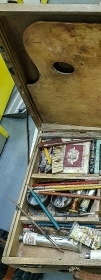
BS Yamey was my father, an art lover who never ever created an oil painting in the 101 years of his life. The box most likely belonged to my mother, HB Yamey, who was a trained artist, both a painter and later a sculptor. My mother left South Africa in early 1948 and married my father on March the 16th 1948 in London. No doubt, the artists’ case was amongst her belongings being shipped from South Africa to her new home in England.
The Pretoria Castle on which the artistic materials travelled had its maiden voyage, soon after my parents married, in July 1948 (https://en.wikipedia.org/wiki/Pretoria_Castle_(1947)). Constructed in Belfast, it was probably the only ship ever launched remotely. The wife of General Jan Smuts (1870-1950) launched the ship by sending a radio signal from her home in the Transvaal to the shipyard in Ulster (www.bandcstaffregister.com/page4349.html).
The dating of the launch means that the case travelled to England no earlier than July 1948. It is labelled with my father’s name and a cabin number. I assume that this means that it is likely that he travelled with it. As the ship was renamed in 1966, we can say that the case made the voyage before that year. Now, my parents spent most of 1950 in Montreal, Canada, and then returned to London by 1951. Possibly, my parents returned to South Africa for a visit between their marriage and my birth, but I have no evidence of this. I was born in 1952, and as far as I can recall from what I have been told, my parents did not return to South Africa until 1955, when I was taken along as well. We travelled by sea, but I have no idea on which vessel we travelled and whether the artist’s case travelled with us. So, because my parents are no longer around to tell me about this case, the date of its journey from the southern to the northern hemisphere must remain a mystery.
September 10, 2021
At the end of the runway at Heathrow Airport
TODAY THE MAIN roads leading from London west, the A4 and the M4, run more or less parallel from Hammersmith west towards Slough and then beyond. Before these roads were modernised, or in the case of the M4 and, existed, the old road from London to Slough and points further west ran through the village of Colnbrook, and onwards to Bath. This was long before London’s Heathrow Airport came into existence. Today, the centre of Colnbrook, bypassed by both the A4 and the M4, lies 1.2 miles west of the western perimeter of the airport. Aeroplanes coming into land fly low over Colnbrook because they are within a minute or two of touching down on the runways. Despite being sandwiched between the airport and the ever-expanding town of Slough and having some new housing, Colnbrook retains many features of a rural English village.
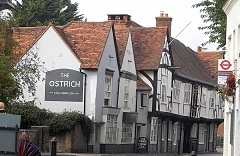
With a bridge crossing the River Colne, a tributary of the Thames, Colnbrook was an important staging post on the coach road between London and the west. An old milestone near The Ostrich pub marks the halfway point between Hounslow (west London) and Maidenhead. A modern sign next to it informs that the toll-road through the village was known as the Colnbrook Turnpike. Writing in 1876, James Thorne noted that during the coaching era, Colnbrook:
“… retained something of its ancient noise and stir; it is now a dull, sleepy, roadside village of a long main street and 2 or 3 shabby offshoots, the many inns testifying to its old character.”
No doubt, the advent of the railways put pay to much of the traffic through the village. It is still rather sleepy if you disregard the ‘planes passing overhead every few minutes. But it is not shabby in my opinion. It has maintained a certain rustic charm and a few of its inns or pubs. Many other buildings in the place have tall archways that might well have led into coaching yards of former hostelries.
A well-restored brick and stone bridge crosses one of the streams of the River Colne. The stonework that lines the tops of the walls of the crossing have carved lettering that shows that the centre of the span was the boundary between Middlesex and Buckinghamshire and that the bridge was built in 1777. A large building with an archway that would have admitted stagecoaches at the eastern entrance to Colnbrook bears the name ‘White Hart House’. When Thorne was writing about the village in 1876, he noted that this was an inn:
“… a good house, with bowling green, and grounds, much in favour for trade dinners and pleasure parties…”
The George Inn, unlike the White Hart, is still in business. It is said that Princess Elizabeth, the future Queen Elizabeth I, might have spent a night there when being taken as a prisoner from Woodstock to Hampton Court in 1588. The pub was first established in the reign of Henry VIII. Its present façade is 18th century (www.sloughhistoryonline.org.uk). Other royal visitors to Colnbrook included the Black Prince with his prisoner King John of France, who were met here by King Edward III (reigned 1327-1377). The half-timbered Ostrich Inn, almost opposite the George, is far older and has a less salubrious history. Its foundations were laid in 1106 but much of its present construction is 16th century. Its name, the Ostrich, might well be a corruption of an earlier name, ‘the Hospice’.
During the 17th century, the Ostrich had an extremely dodgy landlord called Jarman. The pub’s website (https://ostrichcolnbrook.co.uk/history.html) describes his activities well. Here are some extracts from it. Jarman:
“…with his wife made a very profitable sideline by murdering their guests after they had retired for the night.
They had a trap door built into the floor of one of their bedrooms and when a suitably rich candidate arrived Jarman would inform his wife that a fat pig was available if she wanted one! She would reply by asking her husband to put him in the sty for till the morrow. The bedstead was hinged and they would tip the sleeping victim into a vat of boiling liquid immediately below, thus killing him.”
All went well for the Jarmans until they chose a clothier from Reading, named Thomas Cole:
“After persuading him to make his will before he retired, Jarman killed Cole. Unfortunately Cole’s horse was found wandering the streets nearby and caused a search for his owner who had been last seen entering The Ostrich! His body was found some time later in a nearby brook and some say that this Cole-in-the-brook is how Colnbrook got its name. It’s a nice story but whether it is true or not, who’s to say!”
You might be interested to learn that the Ostrich still offers rooms for guests to stay overnight. We met four men, who had done so, sitting quite contentedly in the morning sun that was flooding into the pub’s pleasant courtyard. Despite the story of Thomas Cole, it is far mor likely that the village was originally called ‘Colebroc’ (in 1107) and later ‘Colebrok’ (by 1222).
We visited the parish church of St Thomas just as guest were arriving at a christening. We were given a warm welcome by a female cleric dressed in white with a colourful stole, which she told us that she was wearing at such a happy occasion. The church, a Victorian gothic edifice, was designed by an architect who specialised in Gothic Revival, Benjamin Ferrey (1810-1880). Built between 1849 and 1852, it has walls containing flints. A north aisle, designed by a great practitioner of the Gothic Revival style, George Edmund Street (1824-1881), was added to the church in 1862.
Streams of the River Colne run through parts of the village. In some places their banks are lined with old houses, some half-timbered. Colnbrook, over which millions of people have flown since Heathrow was opened as Great west Aerodrome in 1929 and then as a much larger establishment, now known as London Heathrow, since 1946, is visited by few except mainly locals. Bypassed by major roads and not on the railway, the village has a picturesqueness that rivals many much more frequented places deep in the English countryside. Yet, Colnbrook is a short bus ride from Slough’s railway station and about 40 to 50 minutes’ drive from Hyde Park Corner. Visit the place and be surprised by its charm.
September 9, 2021
Arms and locks
THE GRAND UNION canal, constructed from the late 1790s onwards, is an important artery of England’s canal network. Beginning at Brentford on the River Thames, it winds its way to Braunston and Birmingham. Along its way it meets other canals, some of which are designated ‘arms’. For example, the Paddington Arm joins the main canal at Bulls Bridge in west London and from there it makes its way eastwards to Paddington. Recently, we visited friends, who live in Northamptonshire, and they took us on a walk along another arm of the Grand Union, the Northampton Arm. This branch of the main canal begins near Gayton and Blisworth and runs to nearby Northampton, where it enters the River Nene, which flows eastwards towards The Wash, an enormous inlet of the North Sea.
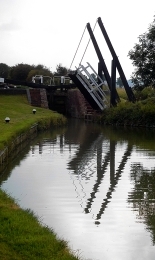 A swing bridge with a lock behind it
A swing bridge with a lock behind itMuch of the Northampton Arm is very narrow, just wide enough for passage of a single narrow boat. At regular intervals, the arm widens to allow vessels travelling in opposite directions to pass each other. Though short in length, only 4.6 miles, the Northampton Arm has seventeen separate, hand-operated locks for vessels to negotiate. The twelve of these, a flight of locks, is 1123 yards from the Gayton junction with the main canal. These twelve locks are along a stretch of canal only nine tenths of a mile long. The northernmost lock, that nearest towards Northampton, is a few yards north of a bridge carrying the M1 motorway. The locks carry the water from a bit over 300 feet above sea level nearest Gayton down to less than about 225 feet, each lock capable of lifting or lowering a vessel over 6 feet on average. Nearer Gayton, there is an old swing bridge, rather like a castle’s drawbridge. Looking at old maps, it appears that there were several more of these along the arm, but we only spotted one in the stretch between Gayton and the M1.
The canal and its associated towpath pass beneath the motorway through a giant concrete arch, paraboloid in shape and reinforced with horizontal concrete beams. Lined with graffiti, both conventional and anarchic artwork, walking under the motorway is an eery, rather science fictional experience. In contrast to this brutalist concrete arch, several lovely brick, hump-backed bridges carry minor roads over the Arm
The authorisation of the Northampton Arm was given in 1793, but it took another 18 years before it was ready for use. A brief hstory of the Arm (https://waterways.org.uk/waterways/discover-the-waterways/grand-union-canal-northampton-arm) relates:
“Almost immediately the Arm began to carry a large volume of merchandise and stayed busy for over 100 years through to after the First World War. In the post war years coal, grain and timber were supplemented by goods needed for the show industry such as strawboards for packing as well as iron ingots for castings. After World War II the carriage of goods ceased as road competition strengthened.”
Now, the Arm is used by intrepid canal boat owners, who are not averse to too much manipulation of lock gates. On the sunny Saturday afternoon that we visited the lock flight, we only saw one narrow boat attempting to negotiate the flight of twelve locks. In contrast, at Gayton Junction, the main Grand Union Canal, from which the Arm branches off, was full of pleasure-seekers’ narrow boats and other craft.
Though hardly used for freight these days, the canal system provides much pleasure to visitors both afloat and on shore. Wandering along the towpaths, one cannot fail to be amazed when considering the engineering ingenuity of the canal builders that we can still see today, as well as the work that is done to keep these waterways usable so many years after they were constructed.



